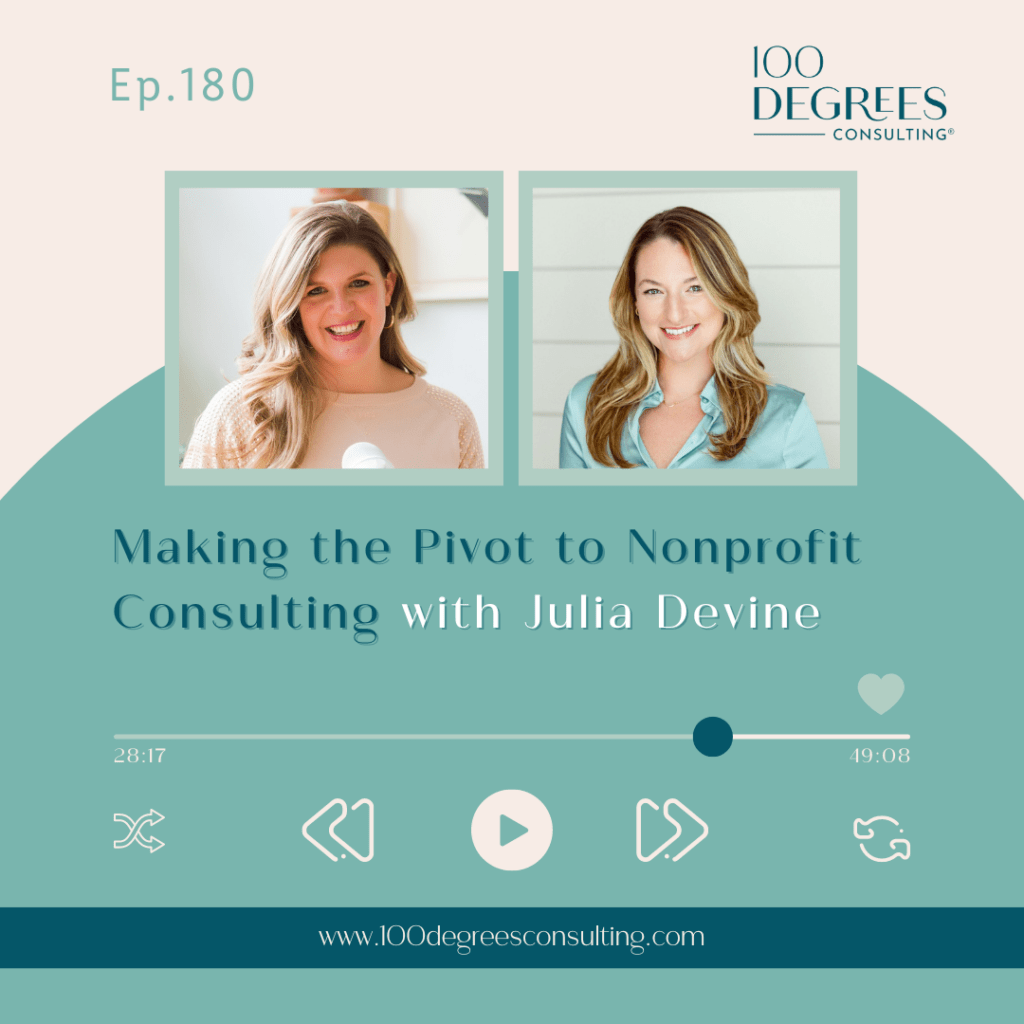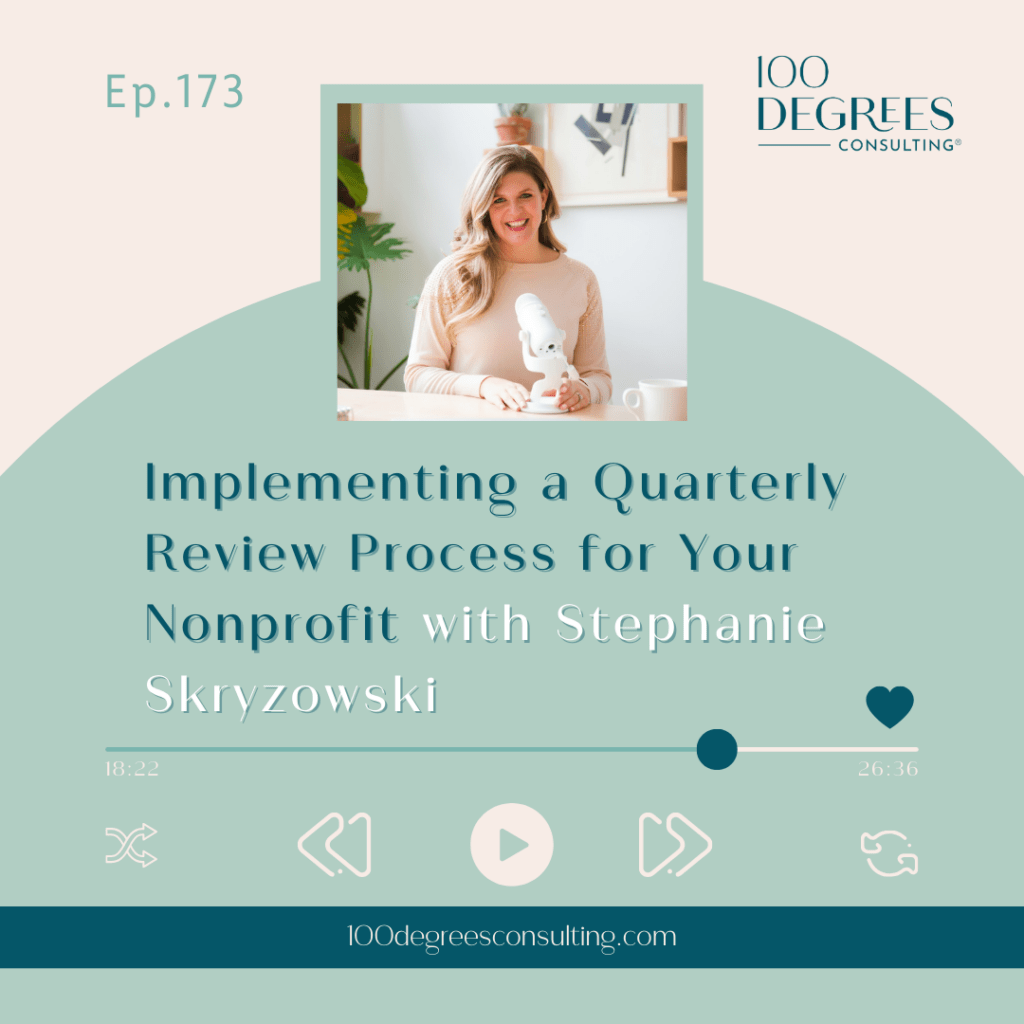Transcript Episode 169 – Start Spending Money on These Five Things on The Prosperous Nonprofit
[00:00:00] Welcome to the prosperous nonprofit, the podcast for leaders who are building financially sustainable and impactful nonprofits and changing the world. I’m Stephanie Skrzewski, a chief financial officer and founder and CEO of 100 degrees consulting. My personal mission is to empower leaders to better understand their numbers, to grow their impact and their income.On this show, we talk to people who are leading the nonprofit sector in new, innovative, disruptive and entrepreneurial ways, creating organizations that fuel their lives, their hearts and their communities. Let’s dive in. We’ll see you
Hey, everybody. Welcome back to The Prosperous Nonprofit. And today we are talking about what nonprofits should start spending money on or maybe spend more money on. So the last [00:01:00] episode was all about what we should stop spending slash wasting money on. And today we’re talking about what you should stop.
Start spending money on. So if you listen to that last episode, as I promised, what is my number one thing? Everyone raise your hand if you remember. So our people, we need to start spending money on our people. And I shared this last time when I talked about self care. Stop spending money on, um, but we do not want to pay our employees just a living wage.
We want to pay them a thriving wage. And I borrowed that quote from Dr. Mark Scott of the OSHI Foundation. And I love that, right? We don’t want our leaders to barely be eking out their living expenses. We want them to live a comfortable life and be able to take care of themselves so that they can show up to work and take care of everyone else that they serve.
Right? Right? So. We need to start spending more money on our people, right? We need to invest in hiring and [00:02:00] retaining qualified staff who are passionate about our work and bring valuable skills and expertise to the table. And again, pay them a thriving wage. So that’s number one. That is what we need to start spending money on.
And this is before. You expand your programs before you grow to another region. Before you invest in that brand new technology, we need to make sure that we can check the box that our team is well paid, right? So that is number one. Number two goes right along with that. Not only do we need to pay our team a thriving wage, but we also need to invest in In their success.
So what does that mean? Well, first of all, making sure that we have money for professional development, making sure that if possible, we are able to provide them with benefits, making sure that there is an adequate infrastructure so that they have the internal support that they need, whether that’s additional.
People to support them or just the time, [00:03:00] right? Your time, maybe as executive director, making sure that you have enough time to be able to actually support this person. Right? So not only paying them well, but also having the resources to make sure that they are set up for success. So that’s professional development.
That’s all those things I just talked about. So that. is what we need to start spending money on. The next thing that we need to start spending money on is infrastructure. Yep, I said it. And you overhead haters, you may come to me, you may come for me thinking like, are you saying that we need to increase our overhead?
No, we’re not increasing our overhead for the sake of increasing our overhead, but we need to start. Start spending adequate money on infrastructure, right? We have to make sure our organization has the right infrastructure and operational support systems in place so that we can function efficiently and effectively.
Y’all have probably heard me tell this story a million [00:04:00] times, but back in the day I had a laptop and it was one of those giant beastly laptops, not the super razor thin ones that we have today. And And it had a sort of a battery in the bottom that you could replace, right? Like you could pop the battery out and put a new one in.
Well, I don’t know what the heck happens, but this battery would just randomly drop out of the bottom of the laptop. And so it would. obviously shut the entire machine down, I would lose everything that I was working on and would have to start over. And so I resorted to duct taping the laptop battery to itself.
And that is like not a way to operate, right? I operated for years with this duct taped laptop battery. And it was inefficient. It was ineffective because it would still kind of like frazzle out and I would lose what I was working on all the time. And that was before everything was instantly saved to the cloud.
Right? So like, bye bye Excel spreadsheets that I just spent.[00:05:00]
So, let’s invest in some infrastructure. Let’s make sure that we have the right technology, that we have the right office space, that we have the right equipment, that we have the right administrative support to really make sure that our day to day operations are functioning smoothly. Because if the office, um, is, uh, you know, a hot mess disaster and nothing is functioning well.
Well, you’re probably not going to get the impact that you want out of your programs either, right? Like we need an organized house in order to be able to go out into the world and have the impact that we want to have. So we’re investing in our team. We’re investing not only their salaries, but also just their environment.
We’re investing in infrastructure. Okay. Other things we want to start spending money on our fundraising. Now, you’re probably already spending money on fundraising, but I want you to think about this and do this a little bit differently instead of just saying, okay, well, we have a development director check.
No, let’s [00:06:00] think about what fundraising activities are we doing that feel like they’re super high impact, like they’re getting the results that we want. And kind of low effort, right? So let’s rank all of the things that we’re doing when it comes to fundraising based on effort and impact. And if we’ve got a bunch of high impact, low effort things, how can we start spending more money on that?
Right? Doubling down on that, doing more of that so that we can get better, more faster results, right? Um, and at the same time, if we were doing the episode that I did on what should you stop spending money on, we need to stop spending money on things that are high effort, low impact. And I gave an example over in that podcast episode, so go listen to that one as well.
So we need to spend more money on activities that are high impact, low effort. Okay. So maybe for you, that is pretty much it. Grant writing, right? Maybe you have a grant writer [00:07:00] who’s amazing, whether a contractor or a full time staff, and that’s your only expense, but you are consistently winning five figure, six figure, maybe even seven figure grants.
Awesome. How can we do more of that, right? Our ROI for that activity. Um, is really good. So I don’t want us to go like willy nilly spending more money on fundraising because Stephanie said so, right? We need to strategically spend more money on fundraising specifically for the activities that are already going well and already working.
Are you tired of navigating the labyrinth of software options, wondering what works best together and how to afford it all? It is a dizzying task from choosing the right accounting software to ensuring seamless integration between all the systems. Feeling lost in the jargon? I Fear not introducing the best tools for an efficient and prosperous nonprofit.
This [00:08:00] free resource is a curated collection of top notch software solutions personally endorsed by our team at 100 degrees consulting. Visit 100degreesconsulting. com slash tools to access our handpicked list designed to streamline your operations and boost your nonprofit success. Without adding a ton of extra cost or extra team.
Don’t miss out. Head to 100degreesconsulting. com slash tools now to download the best tools for an efficient and prosperous nonprofit. Let’s elevate your nonprofit to new heights. Back to the show.
The next thing I want us to spend more money on our programs, right? I’m not saying this just so we can ramp up our program ratio. And again, I have a caveat here. We don’t want to spend money just on all of our programs or any one particular program. I want to spend money on the programs that are having the most impact.
The [00:09:00] highest impact that are getting us closer and closer to whatever our big vision is for our organization. So let’s think about this for a second. Let’s back it up first. We need a big vision, right? And our big vision is not just necessarily to Um, serve more people or help more children, right? What is our big vision?
Are we trying to like eliminate childhood poverty in entire country? Okay, cool. That’s a fantastic vision. What programs do we have that are going to get us closer to that vision, right? And I know a lot of organizations sort of have like a core. Set of programs, maybe a couple of core programs, but I swear there’s always that like tangential program that somebody started a really long time ago and we’ve always been doing it.
And it’s like sort of related to our mission. I, you know, you could certainly make a case that it is, but it’s not that [00:10:00] true driver that’s getting us to what our big vision is for our organization. Yeah. That’s what I want you to think about. It’s like, again, how can we double down on what’s really working well, what’s having the biggest impact and not spend money on the things that are not right.
So that’s why I want you to spend more money on what is having the greatest impact and thinking about really doubling down there. And the last thing that I am going to share with you today of what you should. Start spending money on is a strong financial foundation, right? So listen, at the end of the day, you’re not going to be able to pay your people.
You’re not going to be able to run your programs. If you have a shaky financial foundation, if you have, you know, no cash reserves, if you have a. Yeah. Unreliable rollercoaster of a revenue pipeline. If your expenses are, you know, all over the place, if [00:11:00] you don’t understand budgeting and forecasting and financial analysis, right?
You’re not going to be around for very long. And I think, I hope we can all agree on that, right? Financial sustainability is the name of the game. And what I see. Often is that we feel like we can just kind of whip out a budget or a forecast or an income statement. And we’ve, we’ve checked the box and that’s enough, right?
Because yes, you know, we have to have a budget. The board has to look at it. We need to look at financial statements, but we’re not actually using them. Um, to deepen our knowledge of our numbers to strengthen our financial sustainability. And so what’s the point, right? Like, yes, we have to check the box for sort of good governance and compliance reasons, but you’re not really checking the box if you’re not actually using those numbers.
Right. And so often that means that we need to invest, right? We need to spend money in our organization to [00:12:00] get the right people on board to help us with financial management. Right. Right. Right. Y’all know that’s where we come in, 100 Degrees Consulting. We provide fractional CFO, Chief Financial Officer, and bookkeeping services to help organizations, you know, really better understand, better user numbers to make smart decisions.
And so that’s where we come in, but we’re an investment, right? Or any, any finance person is an investment and it’s often unfortunately not a small investment, right? But having the right people. In these roles are going to help you with your financial planning, with your budgeting, with your risk management, to help ensure your long term viability, your long term resilience, your sustainability, because that’s what they’re experts in.
And so the last thing that I want us to Start spending money in is our financial health by, you know, investing in a finance team. And yeah, of course I want you to work with [00:13:00] us, a hundreddegreesconsulting. com a little plug here. But even if you don’t work with us, you hire a, you know, a bookkeeper or another CFO or, you know, bring a whole finance team in house.
This is a really important investment for your organization to make, um, to help strengthen the financial infrastructure of your organization, which is going to help you be around for the long haul and continue to have the impact that you want to have. So what did we talk about? We talked about a whole bunch of things I want you to start spending money on now.
You may be like, What if we don’t have the budget for all of this? Well, you know what, you probably won’t, um, have exactly the budget you need for all or the budget that you want for all of these things, right? So maybe you start with, okay, let’s get our, all of our staff up to a thriving wage. Let’s start there, right?
And then let’s think about, okay, well, what are the resources might we need to bring other Um, you know, benefits to the table. And I don’t necessarily mean, you know, [00:14:00] medical benefits. I just mean like, what else can we do to support our team? Because at the end of the day, they’re the ones that we need to do our work.
Then I think you should go listen to the other episode. What do we need to say? Stop doing because you may be able to do a little bit of analysis on what you’re spending money on so that you can reallocate some resources, right? Maybe you’re thinking of like dropping 50 grand on a new software and after listening to that episode, you’re like, Ooh, maybe we don’t need to do that.
Okay, well, how can we reallocate that 50, 000 now to some of these other things that I’m talking about? Right. We talked about infrastructure. Um, we did talk about technology and the right technology. Of course, we talked about, you know, really assessing and understanding what is going well with your fundraising activities and doing more of that.
Right. So maybe you could reallocate resources that way. And so even if you don’t have the budget right now to do everything that you want to do. [00:15:00] Think about how you might be able to reallocate some resources from things that you’re doing that maybe aren’t as effective into some of these things that we talked about today.
So listen, you have the power to change things, right? Just because your organization has always done things a certain way, it doesn’t mean you have to do them that way forever. So think creatively. Look at your numbers with a new. Okay, friends, that’s what I have for you today, things that I want you to start spending money on.
All right. Now, please do not go to your board and say, Stephanie says that we need to spend hundreds of thousands of dollars on all these things. So y’all better raise me some more money. Thank you. Please. Please don’t do that. That’s not what I’m saying. I just gave you some things to think about as you may be re forecasting for the [00:16:00] year or you may be reallocating funds or you may be budgeting for next year.
So some things to think about for you. All right. And with all of that, uh, I will catch you next time. Have a great day. Before you go, I just want to thank you for being here. To access our show notes and bonus content, visit 100degreespodcast. com. That’s 100degreespodcast. com. And I’ll see you next time.



















